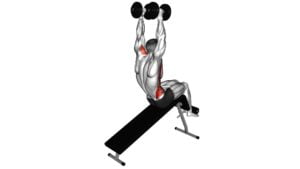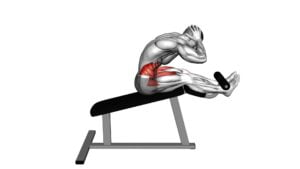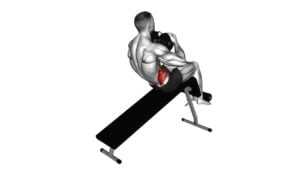Dumbbell Decline Sit-up – Video Exercise Guide & Tips

Looking to amp up your ab workout? Check out this video exercise guide and get ready to feel the burn with the dumbbell decline sit-up.
Watch This Exercise Video
This challenging move targets your core muscles while also engaging your upper body. Learn the proper form and technique, discover variations for added challenge, and find out how to avoid common mistakes.
Get the most out of your workout and take your fitness to the next level with this effective exercise.
Key Takeaways
- Dumbbell decline sit-ups increase resistance and intensity of the exercise.
- Engaging abdominal muscles more effectively is a benefit of dumbbell decline sit-ups.
- Dumbbell decline sit-ups enhance overall stability and coordination.
- Proper form and technique, such as maintaining proper alignment and engaging the core, are important for performing dumbbell decline sit-ups correctly.
Benefits of Dumbbell Decline Sit-up
Experience the numerous benefits of the dumbbell decline sit-up as you strengthen your core and build overall abdominal strength. Incorporating dumbbells into your decline sit-up routine can provide several advantages that enhance the effectiveness of this exercise.
One of the main benefits of using dumbbells during decline sit-ups is that it increases the resistance and intensity of the exercise. By holding the dumbbells against your chest or extending them overhead, you engage your abdominal muscles even more, resulting in a more challenging and efficient workout.
Another advantage of incorporating dumbbells is that it allows for modifications to target different areas of your core. By changing the position of the dumbbells, you can place more emphasis on your upper or lower abs, obliques, or even your hip flexors. This versatility enables you to customize your workout and address specific areas of weakness or desired improvement.
Furthermore, using dumbbells during decline sit-ups helps improve stability and balance. The added weight forces your core muscles to work harder to maintain proper form and control throughout the movement. This not only strengthens your abs but also enhances your overall stability and coordination.
Proper Form and Technique
To perform the dumbbell decline sit-up with proper form and technique, follow these guidelines:
- Maintain proper alignment: Lie on a decline bench with your feet secured and knees bent. Hold a dumbbell against your chest with your elbows tucked in.
- Engage your core: As you exhale, contract your abdominal muscles and lift your torso up towards your thighs. Keep your neck relaxed and your lower back pressed into the bench.
- Control the movement: Slowly lower your torso back down to the starting position while inhaling. Avoid using momentum or jerking motions.
By following these guidelines, you can ensure that you're performing the dumbbell decline sit-up correctly and effectively. This exercise is great for improving core strength and stability. It targets your rectus abdominis, obliques, and hip flexors.
If you're a beginner or need modifications, you can perform the exercise without any weights or use a lighter dumbbell. Additionally, you can bend your knees slightly to reduce the strain on your lower back.
Now that you know the proper form and technique for the dumbbell decline sit-up, let's move on to the next section, where we'll discuss variations for added challenge.
Variations for Added Challenge
To increase the difficulty of the dumbbell decline sit-up, you can try incorporating challenging variations into your routine. These advanced modifications will help you take your core workout to the next level.
One option is to use heavier dumbbells to increase the resistance and engage your abdominal muscles even more.
Another variation is to add a twist at the top of the movement, bringing one elbow towards the opposite knee. This rotational movement targets your obliques and challenges your stability.
You can also try performing the exercise with your feet elevated on a stability ball or a bench. This will increase the range of motion and require more balance and control.
Additionally, you can hold the dumbbells overhead throughout the movement, which adds an extra challenge to your core stability.
Remember to always choose a variation that matches your fitness level and use proper form to prevent injury.
Common Mistakes to Avoid
One common mistake to avoid during the dumbbell decline sit-up is using improper form. Proper alignment is crucial to prevent strain on your neck and back. Keep your spine in a neutral position throughout the movement, engaging your core muscles and maintaining a straight line from your head to your hips.
Another mistake to avoid is forgetting to breathe properly. Breathing techniques can help you maintain control and stability during the exercise. Remember to exhale as you lift your torso up and inhale as you lower it back down. This will provide your muscles with the necessary oxygen and prevent you from holding your breath, which can lead to dizziness or fatigue.
Lastly, avoid using momentum to complete the sit-up. Focus on controlled movements and engage your abdominal muscles to lift your torso, rather than relying on swinging your arms or using your legs for assistance.
Tips for Getting the Most Out of Your Workout
To maximize the effectiveness of your dumbbell decline sit-up and get the most out of your workout, focus on maintaining proper form and engaging your core muscles throughout the movement. By following these tips, you can improve your core strength and maximize calorie burn.
First and foremost, it's crucial to maintain proper form during the exercise. To do this, start by lying on a decline bench with your feet secured at the top. Hold a dumbbell against your chest, and as you perform the sit-up, focus on keeping your back straight and your core engaged. Avoid using momentum or pulling on your neck with your hands.
Engaging your core muscles is essential for targeting and strengthening them. Throughout the movement, consciously contract your abs and lower back muscles. This won't only make the exercise more effective but also help stabilize your body and prevent injuries.
To further maximize your calorie burn, consider adding weight to the dumbbell as you progress. This will challenge your muscles and increase the intensity of the exercise, leading to greater caloric expenditure.
Remember to listen to your body and start with a weight that's appropriate for your fitness level. Gradually increase the weight as your strength improves.
Frequently Asked Questions
How Many Sets and Repetitions Should I Do for the Dumbbell Decline Sit-Up?
For the dumbbell decline sit-up, the number of sets and repetitions will depend on your fitness level and goals. Generally, it's recommended to start with 2-3 sets of 10-15 repetitions.
This exercise variation targets your core muscles and adds resistance with the dumbbells, making it more challenging.
The benefits of the dumbbell decline sit-up include strengthening your abs, improving stability, and increasing overall core strength.
Remember to always consult with a fitness professional for personalized recommendations.
Can I Perform the Dumbbell Decline Sit-Up Without Any Equipment?
Yes, you can perform the dumbbell decline sit-up without any equipment. This exercise offers a great way to target your core muscles and build strength.
By using variations such as bodyweight or resistance bands, you can still challenge yourself and achieve similar benefits as with dumbbells.
It's important to maintain proper form and gradually increase intensity for optimal results. Remember to consult a fitness professional or trainer for guidance on technique and progression.
Is It Necessary to Have a Decline Bench to Do This Exercise?
Yes, it's necessary to have a decline bench to perform the dumbbell decline sit-up. The decline bench provides a stable and angled surface that targets your abdominal muscles more effectively.
However, if you don't have access to a decline bench, there are alternative exercises you can try, such as the regular sit-up or using an exercise ball.
Keep in mind that the decline bench offers unique benefits for abdominal workouts, so it's worth incorporating into your routine if possible.
What Other Exercises Can I Pair With the Dumbbell Decline Sit-Up for a Full Body Workout?
To create a full body workout, you can pair the dumbbell decline sit-up with other exercises. By incorporating dumbbell decline sit-ups into your routine, you can strengthen your core muscles and improve overall stability.
To add intensity, try variations of the dumbbell decline sit-up like adding a twist or using heavier weights.
Pairing this exercise with exercises like push-ups, lunges, and shoulder presses can target different muscle groups, providing a well-rounded workout.
Can the Dumbbell Decline Sit-Up Help Me Achieve a Six-Pack or Toned Abs?
The dumbbell decline sit-up is a great exercise for targeting your abs. It can help you achieve a six-pack or toned abs when combined with other ab exercises.
Compared to other ab exercises, the dumbbell decline sit-up is effective for building abdominal strength.
Incorporating this exercise into your routine will challenge your core and help you achieve the results you desire.
Conclusion
In conclusion, the dumbbell decline sit-up is a highly effective exercise for targeting the core muscles. By incorporating dumbbells and a decline bench, you can increase the challenge and intensity of the workout.
Remember to maintain proper form and technique to avoid common mistakes and maximize the benefits.
With consistency and dedication, this exercise can help you achieve a strong and toned core.

Author
Years ago, the spark of my life’s passion ignited in my mind the moment I stepped into the local gym for the first time. The inaugural bead of perspiration, the initial endeavor, the very first surge of endorphins, and a sense of pride that washed over me post-workout marked the beginning of my deep-seated interest in strength sports, fitness, and sports nutrition. This very curiosity blossomed rapidly into a profound fascination, propelling me to earn a Master’s degree in Physical Education from the Academy of Physical Education in Krakow, followed by a Sports Manager diploma from the Jagiellonian University. My journey of growth led me to gain more specialized qualifications, such as being a certified personal trainer with a focus on sports dietetics, a lifeguard, and an instructor for wellness and corrective gymnastics. Theoretical knowledge paired seamlessly with practical experience, reinforcing my belief that the transformation of individuals under my guidance was also a reflection of my personal growth. This belief holds true even today. Each day, I strive to push the boundaries and explore new realms. These realms gently elevate me to greater heights. The unique combination of passion for my field and the continuous quest for growth fuels my drive to break new ground.







